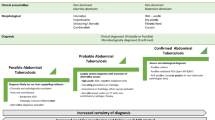Abstract
Incidence of tuberculosis is sharply rising in the United States, and tuberculous peritonitis is often diagnosed late in the course of the disease, resulting in undue patient morbidity and mortality. PURPOSE: Purpose of this study was to better identify which clinical, laboratory, radiologic, and invasive procedures were most useful in diagnosing tuberculous peritonitis. METHODS: All cases of tuberculous peritonitis diagnosed between 1982 and 1994 were reviewed retrospectively to discern which laboratory, radiographic, and procedural tests were helpful in diagnosing the condition. RESULTS: Twenty-eight cases of tuberculous peritonitis were diagnosed during the studied period. Two patients were not diagnosed until autopsy. Patients from all socioeconomic classes and multiple races ranged in age from 3 to 69 (mean, 29.5) years. Most patients presented with a chronic wasting illness, mild abdominal pain, and fever. Purified protein derivative was only positive in 5 of 16 patients. Chest radiographs were suggestive of pulmonary tuberculosis (TB) in five patients. Ultrasound examination of the abdomen was helpful in five patients, and computed tomographic scan was suspicious in 16 of 17 patients. Sputum for acid fast bacillus (AFB) smear was positive in 3 of 14 patients, and paracentesis for AFB smear was positive in 1 of 8 patients. Routine blood work was not helpful. Laparoscopy was diagnostic in five of seven patients. Laparotomy and tissue biopsy of characteristic tissue for AFB smear and culture was diagnostic in 20 of 20 patients. Once diagnosed, all patients responded rapidly to empiric antituberculous medical therapy, except one patient with miliary TB who died shortly after diagnosis. A trend in earlier diagnosis was noted in recent years and is felt to be the result of an elevated index of suspicion. CONCLUSIONS: TB peritonitis may be fatal but is medically cured if diagnosed in a timely fashion. It is essential that the clinician suspect the disease in appropriate patients. Tests frequently associated with TB such as chest radiograph and purified protein derivative are not sensitive in detection of TB peritonitis. Computed tomographic scan is the most useful radiographic study. Mini laparotomy with tissue biopsy for smear and culture is the most sensitive and specific diagnostic procedure.
Similar content being viewed by others
References
Bloch AB, Rieder HL, Kelly GD, Cauthen GM, Hayden CH, Snider DE. The epidemiology of tuberculosis in the United States. Semin Respir Infect 1989;4:157–70.
Anonymous. Prevention and control of tuberculosis in U. S. communities with at-risk minority populations: recommendations of the Advisory Council for the Elimination of Tuberculosis. MMWR Morb Mortal Wkly Rep 1992;41:1–11.
Raviglione MC, Snider DE Jr, Kochi A. Global epidemiology of tuberculosis: morbidity and mortality of a worldwide epidemic. JAMA 1995;273:220–6.
Mehta JB, Dutt A, Harvill L, Mathews KM. Epidemiology of extrapulmonary tuberculosis: a comparative analysis with pre-AIDS era. Chest 1991;99:1134–8.
Lisehora GB, Lee YT, Barcia PJ. Exploratory laparotomy for diagnosis of tuberculous peritonitis. Surg Gynecol Obstet 1989;169:299–302.
Denath FM. Abdominal tuberculosis in children: CT findings. Gastrointest Radiol 1990;15:303–6.
Gitt S, Haddad F, Levenson S. Tuberculous peritonitis: an overlooked diagnosis. Hosp Pract (Off Ed) 1992;27:224–8.
al-Quorain AA, Facharzt, Satti MB, al-Freihi HM, al-Gindan YM, al-Awad N. Abdominal tuberculosis in Saudi Arabia: a clinicopathological study of 65 cases. Am J Gastroenterol 1993;88:75–9.
Lingenfelser T, Zak J, Marks IN, Steyn E, Halkett J, Price SK. Abdominal tuberculosis: still a potentially lethal disease. Am J Gastroenterol 1993;88:744–50.
Sochocky S. Tuberculous peritonitis: a review of 100 cases. Am Rev Respir Dis 1967;95:398–401. nitis: an evaluation of pathogenetic mechanisms, diagnostic procedures and therapeutic measures. N Engl J Med 1969;281:1091–4.
Nafeh MH, Medhat A, Abdul-Hameed AG, Ahmad YA, Rashwan NM, Strickland GT. Tuberculous peritonitis in Egypt: the value of laparoscopy in diagnosis. Am J Trop Med Hyg 1992;47:470–7.
Marshall JB. Tuberculosis of the gastrointestinal tract and peritoneum. Am J Gastroenterol 1993;88:989–99.
Candocia SA, Locker GY. Elevated serum CA 125 secondary to tuberculous peritonitis. Cancer 1993;72:2016–8.
Bloch AB, Cauthen GM, Onorato IM,et al. Nationwide survey of drug-resistant tuberculosis in the United States. JAMA 1994;271:665–71.
Walter N, Krishnaswami H. Granulomatous peritonitis caused by Ascaris eggs: a report of three cases. J Trop Med Hyg 1989;92:17–9.
Voigt MD, Kalvaria I, Trey C, Berman P, Lombard C, Kirsch RE. Diagnostic value of ascites adenosine deaminase in tuberculous peritonitis. Lancet 1989;1:751–4.
Author information
Authors and Affiliations
Additional information
The opinions and assertions contained here are the private views of the authors and are not to be construed as official or as reflecting the views of the Department of the Army or the Department of Defense.
Read at the meeting of The American Society of Colon and Rectal Surgeons, Montreal, Quebec, Canada, May 7 to 12, 1995.
About this article
Cite this article
Lisehora, G.B., Peters, C.C., Lee, Y.T.M. et al. Tuberculous peritonitis-do not miss it. Dis Colon Rectum 39, 394–399 (1996). https://doi.org/10.1007/BF02054053
Issue Date:
DOI: https://doi.org/10.1007/BF02054053



